
I've always trusted Xiaomi for high-end smartphones that deliver great value. But recently, I started wondering how does Xiaomi really stack up against newer competitors like Realme?
Backed by Oppo, Realme has quickly gained attention in the budget and mid-range smartphone space.
So, I decided to put them both to the test. I compared their top smartphones across different price points and even tried their wireless earbuds to get a feel for the full ecosystem.
Here's my take on Xiaomi vs Realme and which one truly delivers more bang for your buck.
Quick Comparison: Xiaomi vs Realme (Updated 2025)
- Best for flagship buyers: Xiaomi delivers stronger displays, cameras, and premium hardware.
- Best for mid-range value: Realme offers better performance-per-dollar in the $200–$400 range.
- Best budget phones: Realme consistently wins with faster processors and better cameras.
- Ecosystem verdict: Realme earbuds provide better sound value, while Xiaomi focuses on premium phone features.
- Overall takeaway: Choose Xiaomi for high-end performance, Realme for maximum value on a budget.
What is Realme?
Realme is a child company of Oppo that began in 2018 and since then has grown to be one of the highest selling smartphone brands in South Asia by 2021. They offer high quality smartphones at a bargain so they can compete with brands like Xiaomi and Samsung.
13 Best AliExpress Alternatives
Xiaomi vs Realme
Xiaomi Mi 11 Ultra vs Realme GT2 Pro
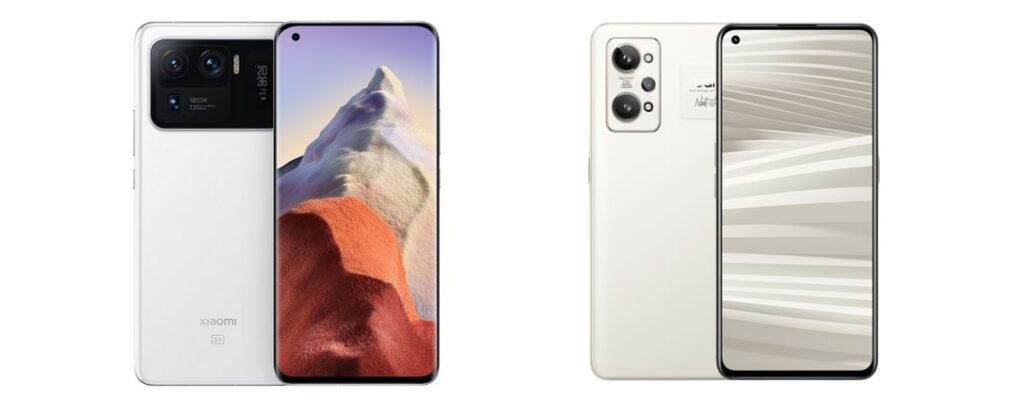
The Realme GT2 Pro was launched earlier this year, whereas the Xiaomi Mi Ultra was launched last year and both devices run on the Snapdragon 888 5G processor which is found in a majority of the flagship smartphones today. Both devices are priced around the same range, but the GT2 Pro is slightly more expensive than the Mi 11 Ultra by approx $100.
There are other key differences we found between these two flagship devices. They are:
Display
The Mi 11 Ultra has a larger screen which is 6.81” as compared to the GT2 Pro’s display which measures at 6.7”. Though the size might not seem like that big of a difference, the overall visual performance and quality of the display is what you need to consider.
For example, the Mi 11 Ultra uses an AMOLED display which produces 1B colors, offers 120Hz refresh rate and additional features like HDR10+ and Dolby Vision which are not available on the GT2 Pro.
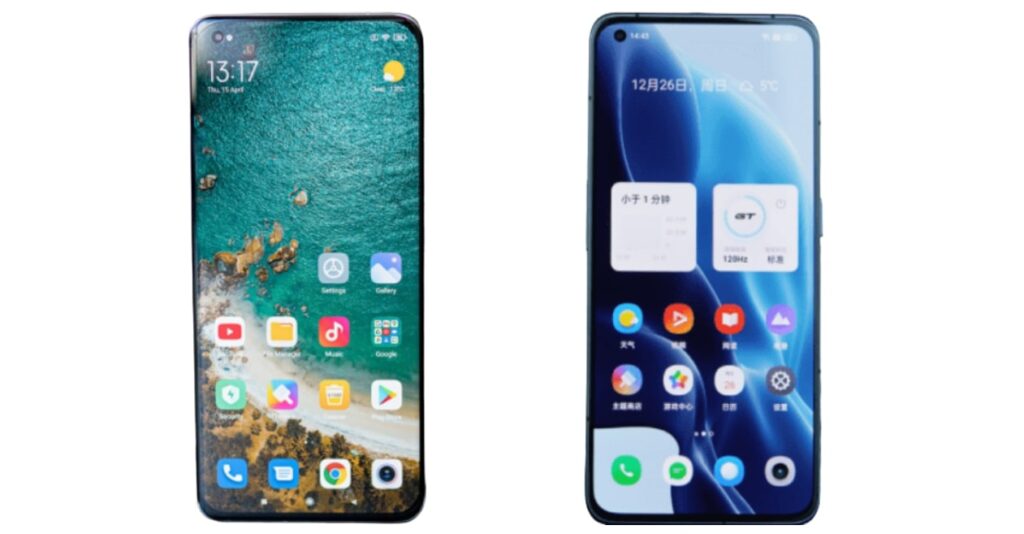
Both devices have Gorilla Glass Victus protection and come with 1440*3200 resolution, but the pixel density on the Xiaomi Mi 11 Ultra is greater than the GT2 Pro making it an overall better display.
Storage & RAM
In terms of storage and RAM, both the Mi 11 Ultra and the GT2 Pro come with 8GB/12GB RAM variants and offer UFS 3.1 internal storage options ranging from 128GB-512GB on the GT2 Pro and 256GB-512GB on the Mi 11 Ultra.
There’s not much difference between both devices when it comes to internal memory and RAM speeds. However, you can end up saving a few bucks on the Realme GT2 Pro 8GB/128GB variant. Also, it’s good to know that both these devices do not offer expandable memory options, so make sure you pick the right one for your needs.
Camera Setup
Taking the primary and selfie cameras into account, the Xiaomi Mi 11 Ultra is equipped with a 50MP triple camera set up that includes a 50MP primary wide lens with OIS and dual pixel PDAF, a secondary 48MP periscope telephoto lens camera with built in OIS, PDAF and 5x Optical zoom and a third 48MP ultrawide lens with PDAF.
The Realme GT2 Pro on the other hand comes with a 50MP primary wide lens with OIS and multi-directional PDAF, a secondary 50MP ultrawide lens and a third 3MP microscope lens with AF and 40x magnification.

Both cameras are epic, but while the Xiaomi does well in full sized shots, the Realme performs better in terms of close ups and far off images.
The front cameras are also different, the Realme has a 32MP wide single lens that supports HDR and panorama whereas the Mi 11 Ultra uses a lower resolution 20MP wide single lens with HDR processing capabilities.
Specifications
| Xiaomi Mi 11 Ultra | Realme GT2 Pro | |
| Processor | Qualcomm SM8350 Snapdragon 888 | Qualcomm SM8450 Snapdragon 8 Gen 1 |
| Display | 6.81” AMOLED;120Hz, HDR10+ | 6.7” LTPO2 AMOLED;120Hz, HDR10+ |
| Camera | 50MP Triple + 20MP Single | 50MP Triple + 32MP Single |
| Battery | 5000mAh;Fast Charge 67W | 5000mAh;Fast Charge 65W |
| Memory/Storage | 8GB/12GB RAM;256GB/512GB | 8GB/12GB RAM;128GB/256GB/512GB |
Flagship Verdict - The Xiaomi Mi 11 Ultra, though an older device, can outperform the GT2 Pro which is Realme’s flagship of 2022. The Mi 11 Ultra is faster, bigger, has a better display and higher resolution camera. It’s also slightly cheaper than the Realme GT2 Pro which is a plus point in our books.
Xiaomi Mi 11X vs Realme GT Neo2
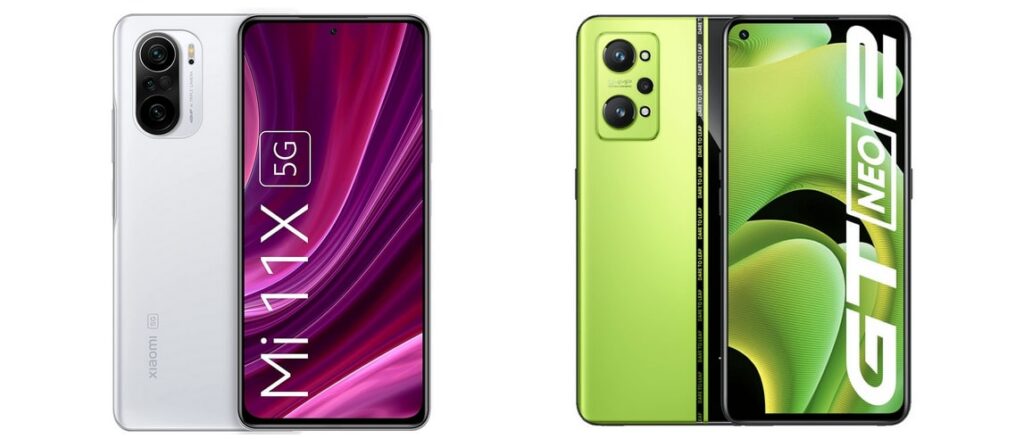
Coming to the mid-range performers, both the Xiaomi Mi 11X and the Realme GT Neo2 run on the Qualcomm Snapdragon 888 processor which ensures a smooth user experience and balanced performance. Both devices are priced under $350 and offer similar features and levels of performance.
Display
There is a very small difference between the displays on the Mi 11X and the GT Neo2 such as the latter is 0.05” smaller than the 11X and that it comes with a regular AMOLED display unlike the Xiaomi which is equipped with a 120Hz Super AMOLED display for better visual performance.
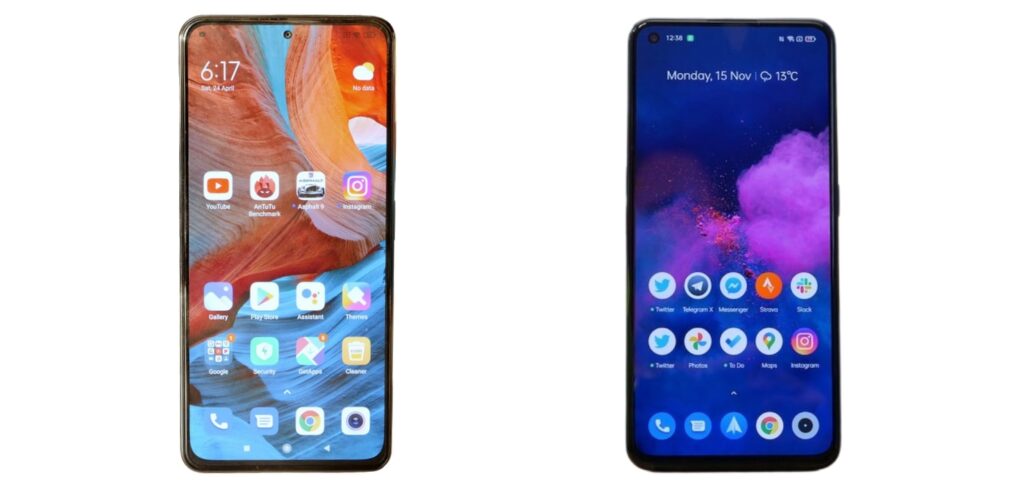
Apart from this, both displays come with 1080*2400 px resolution and use Corning Gorilla Glass 5 protection.
Storage & RAM
The Realme GT Neo2 offers better RAM and storage than the Mi 11X. It comes with a base RAM of 8GB with an upgrade to 12GB and storage options of 128GB/256GB unlike the GT Neo2 which offers a low 6GB RAM and a secondary 8GB RAM apart from the standard 128GB UFS 3.1 internal storage.
Camera Setup
Both devices come with a triple rear camera set up, but the Realme GT Neo2 is equipped with a 64MP PDAF lens whereas the Mi 11X comes with a lower resolution 48MP lens. The overall quality of the rear camera setup is better on the Realme than Xiaomi.

In terms of the front facing camera and video capabilities, the Xiaomi Mi 11X records better videos and comes equipped with a better resolution selfie camera. Both devices deliver clear images and videos and thanks to the built-in LED flash, you get low light images in full resolution as well.
Battery Capacity
Considering the price of these devices, you’d expect them to come equipped with low 3500mAh batteries. But Xiaomi and Realme have stepped up their game and have equipped them with large 4520mAh and 5000mAh batteries respectively.
Both devices offer quick charge capabilities, the Xiaomi Mi 11X charges at 33W allowing it to attain full charge of 100% in under an hour whereas the GT Neo2 uses a better charger and delivery system of 65W which can get the device to full capacity in under 35 minutes.
The Mi 11X also comes with Quick Charge 3+ and Power Delivery 3.0, but considering their batteries run out quite fast, Xiaomi should have invested in upgrading the battery a bit over adding charging features to their device.
Specifications
| Xiaomi Mi 11X | Realme GT Neo2 | |
| Processor | Qualcomm SM8250 Snapdragon 870 5G | Qualcomm SM8250 Snapdragon 870 5G |
| Display | 6.67” Super AMOLED;120Hz, HDR10+ | 6.62” AMOLED;120Hz, HDR10+ |
| Camera | 48MP Triple + 20MP Single | 64MP Triple + 16MP Single |
| Battery | 4520mAh;Quick Charge at 33W | 5000mAh;Quick Charge at 65W |
| Memory/Storage | 6GB/8GB RAM;128GB | 8GB/12GB RAM;128GB/256GB |
Mid-Range Verdict - Though both the Xiaomi Mi 11X and the Realme GT Neo2 look and feel alike, they are different in so many ways. Apart from the displays used (which is sort of similar), the Realme GT Neo2 comes equipped with better storage options, has a better camera setup and uses a high-performance 5000mAh battery with quick charge capabilities making it the better choice among the two.
Xiaomi Redmi 10 vs Realme 8

Now it’s time to break down the budget-friendly options, the Redmi 10 and the Realme 8. Both devices are priced under $200 and while they both run on Octa core processors, there’s a difference in terms of the chipset and other key features. Let’s take a quick look at which one is the better budget-friendly choice.
Processors
Both the Xiaomi Redmi 10 and the Realme 8 run on MediaTek processors with eight cores under the hood. But surprisingly, the Redmi 10 comes equipped with an older chipset, the MediaTek Helio G88 whereas the Realme 8 uses the latest G95 chip making it a better performer.
Even the graphics processors are different with the Xiaomi using an older Mali-G52 MC2 and the Realme using a new and improved Mali-G76 MC4. They run smooth, but you will notice a slight difference in load times and a lag while scrolling through apps on the Xiaomi because of the older processor.
Display
Xiaomi devices are known for their beautiful displays and even though the Redmi 10 is quite an affordable device, Xiaomi has managed to equip it with a clear 90Hz 6.5” LCD display. However, that’s not a match for the 6.4” Super AMOLED screen with HDR10 that’s on the Realme 8.
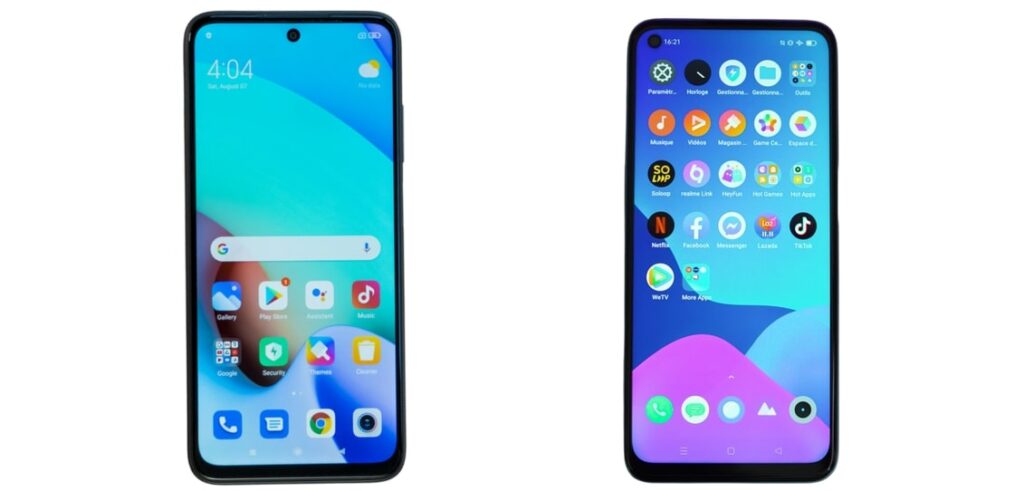
Both devices cap out at 1080p resolution and roughly the same pixel density which is pretty decent. I would recommend the Realme for the display in this segment mainly because it’s built to deliver better quality visuals and a brightness of 100 nits (peak).
Storage & RAM
If it’s RAM and storage variants you’re looking for, the Realme 8 wins hands down. It comes with 4GB/6GB and even 8GB RAM variants along with UFS 2.1 internal storage options of 64GB and 128GB which is ideal for hundreds of photos and videos.
The Xiaomi Redmi 10 on the other hand comes with two RAM variants 4GB and 6GB along with two eMMC 5.1 internal storage variants; 64GB and 128GB. In terms of boot speed, the Realme 8 is much faster thanks to the UFS2.1 over the slower eMMC 5.1. With both devices you get a dedicated microSDXC slot that you can use to expand your storage up to 512GB.
Camera Setup
Now coming to the camera setup on both the Xiaomi Redmi 10 and the Realme 8, both devices use quad cameras, but the Realme comes equipped with a larger resolution lens and 4K video recording capabilities which the Xiaomi lacks.
Images and videos are clearer and more detailed on the Realme 8 and with the help of the built-in camera sensors, this smartphone can record and shoot in HDR way better than the Redmi 10.

The front facing camera on the Realme 8 is also better than the one on the Redmi 10. Realme has used a nice 16MP HDR lens that is capable of 1080 video recording and uses a gyro-EIS program to produce detailed and crisp images. The Xiaomi uses an 8MP single lens HDR camera which is great, but not as good as the Realme 8.
Specifications
| Xiaomi Redmi 10 | Realme 8 | |
| Processor | MediaTek Helio G88 | MediaTek Helio G95 |
| Display | 6.5” IPS LCD;90Hz, HDR10 | 6.4” AMOLED;60Hz, HDR10 |
| Camera | 50MP Quad + 8MP Single | 64MP Quad + 16MP Single |
| Battery | 5000mAh;Fast Charging at 18W | 5000mAh;Fast Charging at 30W |
| Memory/Storage | 4GB/6GB RAM;64GB/128GB | 4GB/6GB/8GB RAM;64GB/128GB |
Budget-Friendly Verdict - The best budget smartphone title belongs to Realme with their high-performance low-budget smartphone, the Realme 8. It has a better camera, processor, battery and even storage/RAM options than the Xiaomi Redmi 10. Also it’s priced around $30 lower than the Xiaomi making it the ideal choice for those on a tight budget.
Overall Verdict: Xiaomi vs Realme - Smartphones
Based on our tests and what we experienced, Xiaomi remains undefeated in their high-end devices, but as we moved on to the mid-range and budget devices it became evident that Realme does a better job of delivering high-performance machines for cheaper prices.
If you need a device for everyday use and are on a budget then the best choice you got is Realme. However if you want a flagship worthy device and don’t mind how much you’re going to spend then stick to Xiaomi and you won’t be disappointed.
Xiaomi vs Realme - Earbuds
Xiaomi Redmi AirDots vs Realme Buds Q
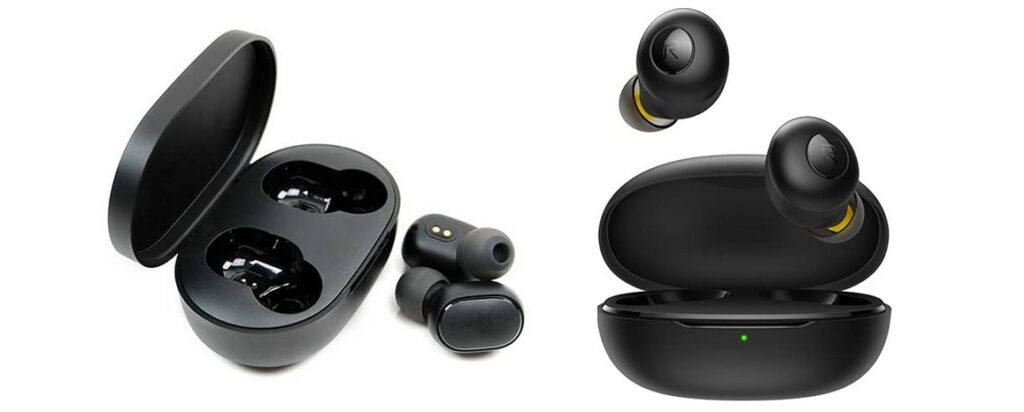
Yes, there are earbuds from brands like Apple, Bose, Beats and Sony that will give you a true theater-grade listening experience. But it’s always better to stick to earbuds manufactured by the same company as your smartphone.
That being said, Xiaomi and Realme have launched a bunch of earbuds you can buy. They are much more affordable and far more effective than big name brands especially if you pair them with your Xiaomi/Realme smartphone.
But which one to go for? I’ve considered two of the best TWS Chinese earbuds in the market for this comparison, the Xiaomi Redmi AirDots and the Realme Buds Q.
Let’s take a look at some key specs from each device as we determine which earbuds are the best.
Design
When it comes to the overall design, the AirDots and the Buds Q are sleek and compact earbuds that sit comfortably in your ears. They both are designed to fit the contour of your ear canal and do not fall out if you’re jogging, running or just working out in general.
Both devices offer IPX4 protection from sweat/light splashes and have been made from premium-quality materials and components. You can also pick up either the Xiaomi Redmi AirDots or the Realme Buds Q in one of over 5 colors online, at the same rate.
Sound Quality
Ultimately, there are two main things to consider when buying earbuds, one is design and level of comfort and the second is the quality of sound produced through them. For example, both earbuds come with Stereo speakers that are capable of delivering sound from individual channels.
The Realme Buds Q uses 10mm Neodymium drivers which are well known for their heightened performance, whereas the Redmi AirDots come with traditional 7.2mm dynamic drivers which are pretty great but don’t deliver the best sound quality when compared to the Buds Q.
Connectivity
Both earbuds are equipped with Bluetooth 5.0 that offer 10m range from your connected device. You would require the charging case only to pair the earbuds with your phone and you’re good to go.
Unfortunately, both devices do not support aptX or audio pairing using NFC which is pretty common these days. But considering these devices cost under $30, we can’t complain.
Additional Features
The good thing about these devices is that they both support fast charging technology so you can quickly charge your earbuds/charging case and get back to listening to music in no time.
The Buds Q and the AirDotos can be used as headsets to handle calls thanks to their built-in microphones and because of this you can also directly command your voice assistant to pull up information like the weather, news, read your messages, play music and more.
They’re user-friendly earbuds and you can download their proprietary software for your device from the Play Store and gain more control over the earbuds.
Specification
| Xiaomi Redmi AirDots | Realme Buds Q | |
| Driver | 7.2mm Dynamic | 10mm Neodymium |
| Battery Life | 40mAh; 12 Hours | 40mAh; 4.5 Hours |
| Charging Time | 1.5 Hours | 1.5-2 Hours |
| Connectivity | Bluetooth 5.0 | Bluetooth 5.0 |
Overall Verdict - Xiaomi Redmi AirDots vs Realme Buds Q
Overall, I found the Realme Buds Q to be better than the Xiaomi Redmi AirDots. They have larger drivers which are neodymium magnets, can charge in a shorter span of time and offer more than 30% more playtime with the charging case when compared to the AirDots.
However, if you are on a tight budget and don’t mind compromising a bit on the sound quality and experience, then go ahead with the Redmi AirDots, you won’t regret it.
FAQ’s
Which is better, Xiaomi or Realme?
When it comes to high end smartphones, Xiaomi delivers better quality devices over Realme. Realme is better known for their mid--range and low-budget smartphones and high quality TWS earbuds.
Why are Realme phones so cheap?
Realme phones are cheap because Oppo has put in the effort and funding for Realme to take over the mid-range and budget segments. Also their devices are made in China and the overall cost to produce one smartphone is low when compared with other international brands
Takeaway
By now you must have realized that not all devices offer the same levels of performance even though their costs are quite similar. From this I was able to draw the conclusion that Xiaomi devices are good only if you’re going for a high-end flagship spec phone.
But if you want something that’s worth your money and available on a budget then choose a Realme smartphone. You won’t regret it.
Both companies are unique in their own way and Realme is certainly catching up with Xiaomi in terms of sales performance and user satisfaction. Even their TWS Buds Q earbuds are not just affordable but offer a better user experience than the Xiaomi AirDots.
Are Huawei Smartwatches Worth It in 2025? Honest Review
Top-Rated Aliexpress NATO Straps of 2025: In-Depth Reviews and Buying
Is Aliexpress Legit & Safe? Are Aliexpress Products Fake?





